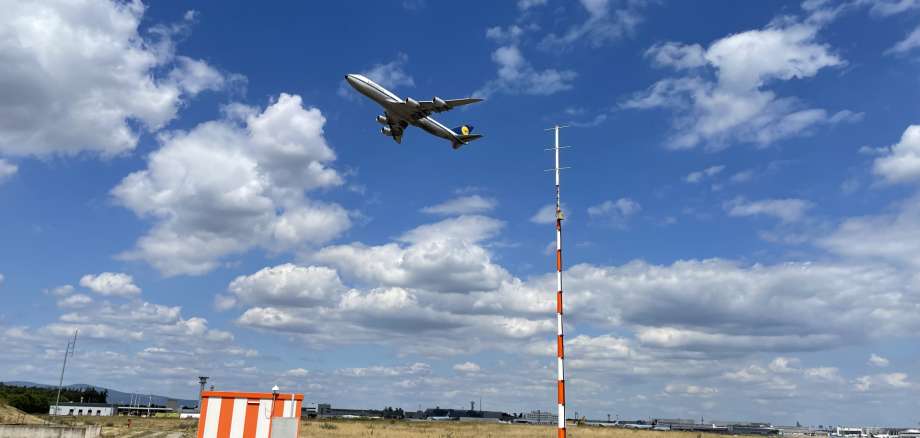Within the SESAR DREAMS project (Demonstration of Runway Enhanced Approaches Made with Satellite Navigation), they demonstrated the precision of the system. In July 2022, DFS published GLS CAT II procedures with 3 and 3.2 degree glideslopes for public use at Frankfurt Airport.
Rationalisation is a key element of the European communication, navigation and surveillance (CNS) strategy. Satellite-based landing systems using ground-based augmentation are currently being developed and deployed worldwide.
"Paving the way towards digitalisation"
Friedrich-Wilhelm Menge, CTO on the DFS Executive Board, thanked the jury for selecting the future-oriented GBAS technology and said: “Enabling GBAS for low visibility operations at Frankfurt Airport is a consistent step in paving the way towards the digitalisation of precision approach landing techniques. We want to encourage the whole aviation community to further push these developments.”
Jörg Pikolin, Head of ATM Development & Regulatory Affairs Flight Operations at Lufthansa: “Innovation is the key to realising more sustainable and environmentally friendly operations. Therefore, we as Lufthansa not only support but are actively engaged in developing promising technologies such as GBAS.”
To increase the integrity of the GBAS ground system, an SBAS receiver has been integrated into the GBAS station at Frankfurt Airport. By using specific information from EGNOS, GBAS can assess the ionospheric conditions for an expanded regional area. If ionospheric activity is low, the system allows for higher integrity sufficient for CAT II low visibility conditions. Then, the station supports CAT II operations for GAST C equipped airborne users. In case of increased ionospheric activity, the station reverts to its CAT I capability.
GBAS excelled in its category among 80 projects in total
Within the GBAS ground station environment mentioned above, Airbus supported the airworthiness demonstration for the airborne part and accordingly received the GBAS CAT II EASA approval for A320 family aircraft in July 2022.
The ATM Awards were handed out by Air Traffic Management Magazine and the Civil Air Navigation Services Organisation (CANSO) at Airspace World 2023, which took place in Geneva from 8 to 10 March. GBAS excelled in its category among 80 projects in total. The ATM Awards acknowledge pioneering concepts, initiatives and significant achievements in the air traffic management industry.
Media contact:
Nanda Geelvink
DFS Deutsche Flugsicherung GmbH
E-mail: nanda.geelvink@dfs.de
Phone: +49 (0)6103 707-4164
DFS Deutsche Flugsicherung GmbH, the German air navigation service provider, is a State-owned company under private law with 5,600 employees as at 31 December 2022. DFS ensures the safe and punctual flow of air traffic over Germany. Around 2,200 air traffic controllers guide more than three million flights through German airspace in peak years, up to 10,000 every day. The company operates control centres in Bremen, Karlsruhe, Langen and Munich as well as control towers at the 15 designated international airports in Germany. The subsidiary DFS Aviation Services GmbH markets and sells products and services related to air navigation services, and provides air traffic control at nine regional airports in Germany and at Edinburgh Airport in the UK. DFS is working on the integration of drones into air traffic and has set up a joint venture, Droniq GmbH, with Deutsche Telekom. Other subsidiaries include R. Eisenschmidt GmbH, which markets publications and products for general aviation, and Kaufbeuren ATM Training GmbH (KAT), which provides training for military air traffic services personnel. The joint venture FCS Flight Calibration Services GmbH offers flight inspection service.
SESAR
As the technological pillar of the Single European Sky initiative, SESAR aims to modernise and harmonise air traffic management (ATM) in Europe. The SESAR Joint Undertaking (SESAR JU) was established in 2007 as a public-private partnership to support this endeavour. It does so by pooling the knowledge and resources of the entire ATM community in order to define, research, develop and validate innovative technological and operational solutions. The SESAR JU is also responsible for the execution of the European ATM Master Plan which defines the EU priorities for R&D and implementation. Founded by the European Union and Eurocontrol, the SESAR JU has 19 members, who together with their partners and affiliate associations will represent over hundred companies working in Europe and beyond. The SESAR JU also works closely with staff associations, regulators, airport operators and the scientific community.
This project has received funding from the SESAR Joint Undertaking (JU) under grant agreement No 874469.
